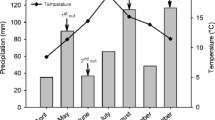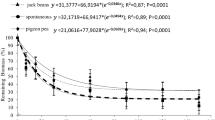Abstract
Sustainable management of mineral nutrition in vineyards, as well as in other fruit plantations, should aim at exploiting the use of internal sources of nutrients, in order to reduce the need for external nutrient inputs. In this paper we explore the potential of the grassed alleys to provide nutrients to the vines. We followed for one vegetative season the decomposition of ryegrass and clover, frequently present as floor vegetation in vineyards, using litter bags filled with 15N-enriched grass material. In addition, we quantified the amount of nitrogen (N) transferred from the decomposing litter to field-grown grapevines. Ryegrass and clover had a relatively rapid decomposition rate, with a loss of C approaching 80% in only 16 weeks. The release of nutrients was particularly fast for potassium (95% in 16 weeks) followed by nitrogen (80%), calcium (70–80%), phosphorous (65–85%), magnesium (70–75%), and sulfur (60–70%). In spite of the rapid release of N from decomposing material, the N uptake by grapevines was on average less than 4% of the initial amount of N present in the litter of ryegrass and clover. Even if N release during the decomposition of mowed perennial ryegrass and white clover little contributed to the N nutrition of grapevine in the same growing season, most N from mowed grassed was still recovered in the soil.



Similar content being viewed by others
References
Aber JD, Martin M (1999) Leaf chemistry, 1992-1993 (ACCP). NASA’s (ACCP) 2002. Accelerated canopy chemistry program. Oak Ridge National Laboratory, TN
Aber JD, Melillo JM (2001) Terrestrial ecosystems. Academic Press, San Diego
Agehara S, Warncke DD (2005) Soil moisture and temperature effects on nitrogen release from organic nitrogen sources. Soil Sci Soc Am J 69:1844–1855
Blaschke L, Forstreuter M, Sheppard LJ, Leith UK, Murray MB, Polle A (2002) Lignification in beech (Fagus sylvatica) grown at elevated CO2 concentrations: interaction with nutrient availability and leaf maturation. Tree Physiol 22:469–477
Brunetto G, Ceretta CA, Kaminski J, Melo GWB, Girotto E, Trentin E, Lourenzi CR, Vieira RCB, Gatiboni LC (2009) Produção e composição química da uva em videiras submetidas à adubação nitrogenada na Serra Gaúcha do Rio Grande do Sul. Ciência Rural 39:2035–2041
Cabrera ML, Kissel DE, Vigil MF (2005) Nitrogen mineralization from residues: research opportunities. J Environ Qual 34:75–79
Castelan-Estrada M, Vivin P, Gaudilliere JP (2002) Allometric relationships to estimate seasonal above-ground vegetative and reproductive biomass of Vitis vinifera L. Ann Bot 89:401–408
Colugnati G, Crespan G, Picco D, Bregant F, Tonetti I, Gallas A, Altissimo A (2003) Comportamento di diverse essenze per l’inerbimento del vigneto. L’informatore agrario 13:55–59
Couteaux MM, Bottner P, Berg B (1995) Litter decomposition, climate and litter quality. Tree 10:63–66
de Neergaard A, Hauggaard-Nielsen H, Jensen LS, Magid J (2002) Decomposition of white clover (Trifolium repens) and ryegrass (Lolium perenne) components: C and N dynamics simulated with the DAISY soil organic matter submodel. Eur J Agron 16:43–55
Harmon ME, Nadelhoffer KJ, Blair JM (1999) Measuring decomposition, nutrient turnover, and stores in plant litter. In: Robertson GP, Coleman DC, Bledsoe CS, Sollins P (eds) Standard soil methods for long-term ecological research. Oxfort University Press, New York, pp 202–240
Intrieri C, Lia G, Filippetti I, Colucci E, Altissimo A, Poni S (2002) Comportamento di specie erbacee nell’inerbimento di vigneti. L’informatore agrario 10:83–89
King AP, Berry AM (2005) Vineyard 15N, nitrogen and water status in perennial clover and bunch grass cover crop systems of California’s central valley. Agr Ecosyst Environ 109:262–272
Magill AH, Aber JD (1998) Long-term effects of experimental nitrogen additions on foliar litter decay and humus formation in forest ecosystems. Plant Soil 203:301–311
Patrick AE, Smith R, Keck K, Berry AM (2004) Grapevine uptake of 15N labeled nitrogen derived from a winter-annual leguminous cover-crop mix. Am J Enol Viticul 55:187–190
Steenwerth KL, Belina KM (2010) Vineyard weed management practices influence nitrate leaching and nitrous oxide emissions. Agr Ecosyst Environ 138:127–131
Stevens CJ, Quinton JN (2009) Diffuse Pollution Swapping in Arable Agricultural Systems. Critical Rev Environ Sci Technol 39:478–520
Tagliavini M, Tonon G, Scandellari F, Quiñones A, Palmieri S, Menarbin G, Gioacchini P, Masia A (2007) Nutrient recycling during the decomposition of apple leaves (Malus domestica) and mowed grasses in an orchard. Agr Ecosyst Environ 118:191–200
Tallec T, Diquelou S, Avice JC, Lesuffleur F, Lemauviel-Lavenant S, Cliquet JB, Ourry A (2009) Availability of N and S affect nutrient acquisition efficiencies differently by Trifolium repens and Lolium perenne when grown in monoculture or in mixture. Environ Exp Bot 66:309–316
Toselli M, Baldi E, Sorrenti G, Quartieri M, Marangoni B (2010) Evaluation of the effectiveness of soil-applied plant derivatives of Meliaceae species on nitrogen availability to peach trees. Sci Hortic 124:183–188
Trinsoutrot I, Recous S, Bentz B, Line`res M, Che`neby D, Nicolardot B (2000) Biochemical quality of crop residues and carbon and nitrogen mineralization kinetics under nonlimiting nitrogen conditions. Soil Sci Soc Am J 64:918–926
Tutua SS, Goh KM, Daly MJ (2002) Decomposition and nitrogen release of understorey plant residues in biological and integrated apple orchards under field conditions in New Zealand. Biol Fertil Soils 35:277–287
Van Eekeren N, van Liere D, de Vries F, Rutgers M, de Goede R, Brussaard L (2009) A mixture of grass and clover combines the positive effects of both plant species on selected soil biota. Appl Soil Ecol 42:254–263
Ventura M, Scandellari F, Bonora E, Tagliavini M (2009) Nutrient release during decomposition of leaf litter in a peach (Prunus persica L.) orchard. Nutr Cycl Agroecosyst 87:115–125
Acknowledgments
To CAPES Foundation (Brazilian Federal Agency for Support and Evaluation of Graduate Education) (BEX 2139/06-5) for the scholarship of doctorate “sandwich” for the first author. The authors are in debt with Prof. Cesare Intrieri and Dr. Ilaria Filippetti for their support and for having hosted this study in the experimental fields managed by the Viticulture section of the Department of Fruit and Woody Plant Sciences, University of Bologna, Italy.
Author information
Authors and Affiliations
Corresponding author
Rights and permissions
About this article
Cite this article
Brunetto, G., Ventura, M., Scandellari, F. et al. Nutrient release during the decomposition of mowed perennial ryegrass and white clover and its contribution to nitrogen nutrition of grapevine. Nutr Cycl Agroecosyst 90, 299–308 (2011). https://doi.org/10.1007/s10705-011-9430-8
Received:
Accepted:
Published:
Issue Date:
DOI: https://doi.org/10.1007/s10705-011-9430-8




